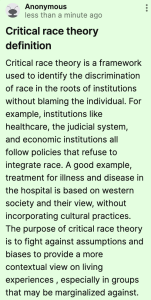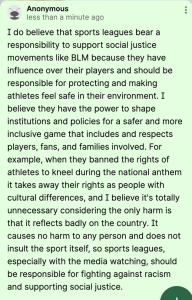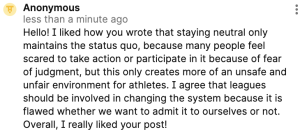3
Section One: The Fundamentals
A) Keywords
Exercise 1:
Briefly (in 100 words or less) define one of the keywords in the padlet (including one that you. may have added yourself).
| Critical race theory definition:
Critical race theory is a framework used to identify the discrimination of race in the roots of institutions without blaming the individual. For example, institutions like healthcare, the judicial system, and economic institutions all follow policies that refuse to integrate race. A good example, treatment for illness and disease in the hospital is based on western society and their view, without incorporating cultural practices. The purpose of critical race theory is to fight against assumptions and biases to provide a more contextual view on living experiences , especially in groups that may be marginalized against. .
|
B) Representing Race
Exercise 2: Notebook Prompt
In about 50-70 words, consider Joel Bervell’s question: why do we feel the need to extrapolate the athleticism of one Black athlete to all Black people when we do not do the same for white athletes?
Try to think of examples when this happens, making sure to reflect on your own positionality.
| The need to extrapolate the athleticism of one black athlete to the rest is due to historical factors and the discrimination of race that our society is rooted in. Because society was developed by western or white people, the lens of black people can lead to stereotyping including the stereotype that black athletes are naturally stronger or faster. In addition, it gives people an excuse to make sense of society when education is lacking. |
C) Gender, Race & Sport
Exercise 3: Notebook Prompt
What are some strategies for resistance that Rajack and Joseph identify in their article as a means of pushing back against and resisting misogynoir?
| Some strategies for resistance identified are to look at the intersections of cultural, national, gendered and experiential in black athletes to be able to consider athletes identities as a whole. Using new media to show new perspectives of the diversity in sports and change how people should be represented. It is a way to fight against racism and sexism on the internet by spreading awareness as well as education to others about misogynoir. |
Section Two: Making Connections
A) Athlete Activism
Exercise 3: Padlet Prompt
Do athletes have a responsibility to use their platform for social change? Why or why not? Please remember to record your response in both the padlet below and in your Notebook.

B) Athlete Activism & Feminism
Exercise 4: Complete the activities
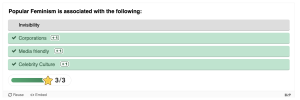

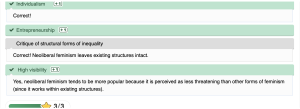

Exercise 5: Notebook Prompt
What do the authors of the article call for as a way of challenging how mainstream sports journalism privileges neoliberal feminist concerns? (100 words max.)
| Instead of telling stories about feminism’s past, present, future, we tell different stories about investigating the ways other dominant stories get made, therefore disrupting the validity of the other stories being told. This way, we reveal patterns in other writings resulting in the observation of masculinist biases or wrong representations. |
C) Corporate social justice
Exercise 6: Padlet Poll
|
I do believe that sports leagues bear a responsibility to support social justice movements like BLM because they have influence over their players and should be responsible for protecting and making athletes feel safe in their environment. I believe they have the power to shape institutions and policies for a safer and more inclusive game that includes and respects players, fans, and families involved. For example, when they banned the rights of athletes to kneel during the national anthem it takes away their rights as people with cultural differences, and I believe it’s totally unnecessary considering the only harm is that it reflects badly on the country. It causes no harm to any person and does not insult the sport itself, so sports leagues, especially with the media watching, should be responsible for fighting against racism and supporting social justice.
Response: Hello! I liked how you wrote that staying neutral only maintains the status quo, because many people feel scared to take action or participate in it because of fear of judgment, but this only creates more of an unsafe and unfair environment for athletes. I agree that leagues should be involved in changing the system because it is flawed whether we want to admit it to ourselves or not. Overall, I really liked your post!
|
Section Three: Taking a shot
Module Assignment (submit as part of notebook and separately through Blackboard mini assignment #1 portal)
For this assignment, I have chosen to analyze the representation of Jackie Robinson from the movie 42. Athletes may refuse to cooperate unless being treated with respect. For example, when the bus stopped for gas and the white guy filling up their tank would not let him use the bathroom so robinson told the guy to stop because they would find someplace else to fill it. Athletes also will use ignorance to avoid the racial comments and continue playing the sport they came to play. For example, when Robinson dodged a question from the reporter “what will you do if the ball gets thrown at your head” and he replies “duck”. Athletes receive lots of negative commentary like the booing of crowds. Even coaches have beliefs rooted in historical contexts as demonstrated when the coach of Robinson commented “don’t get too excited, he’s still a black guy”. Despite the negative commentary, there is also positive commentary. For example, a guy approached Robinson privately and told him he was on his side along with a lot more people from that area. Representations are informed by multiple identities, but sometimes certain ones become overlooked, including race. In an article by Razack & Joseph, 2021, it is stated that; “Racial ambiguity is often met with confusion and identities become exoticized, objectified and not historically contextualized.” Robinson was identified as the black guy in the baseball league and people were more focused on getting rid of him, instead of recognizing the barriers he had overcome like living in an area of dominantly white people and facing racism. Even the team tried signing a petition to get rid of him when they should have been recognizing his skill in baseball. These representations shape the way we understand sports. We have common images we paint in our heads of athletes who are strong and fast but anyone, regardless of their representations, can have the capabilities or strength to play sports. For example, the book Gender Justice? talks about how the needs of muslim women are framed as different and less worthy than those of the cultural majority (Rozaitul et al., 2017), but muslim women are still good enough to be in the olympics. This demonstrates that stereotypes do not define a person and all people are unique in their own ways but may also be equal in sports. Jackie Robinson fought for social justice and was rewarded with the label ‘hero’. This shapes sports to be understood as an inclusive environment where everyone has a fair chance no matter their race, gender, or other identities.
References
Razack, S., & Joseph, J. (2021). Misogynoir in women’s sport media: race, nation, and diaspora in the representation of Naomi Osaka. Media, Culture & Society, 43(2), 291-308. https://doi-org.proxy1.lib.trentu.ca/10.1177/0163443720960919
Rozaitul, M., Dashper, K., Fletcher, T., Watson, B., & Long, J. (2017). Gender justice?: Muslim women’s experiences of sport and physical activity in the UK. In Sport, Leisure and Social Justice (1st ed., Vol. 1, pp. 70–83). Routledge. https://doi.org/10.4324/9781315660356-6

